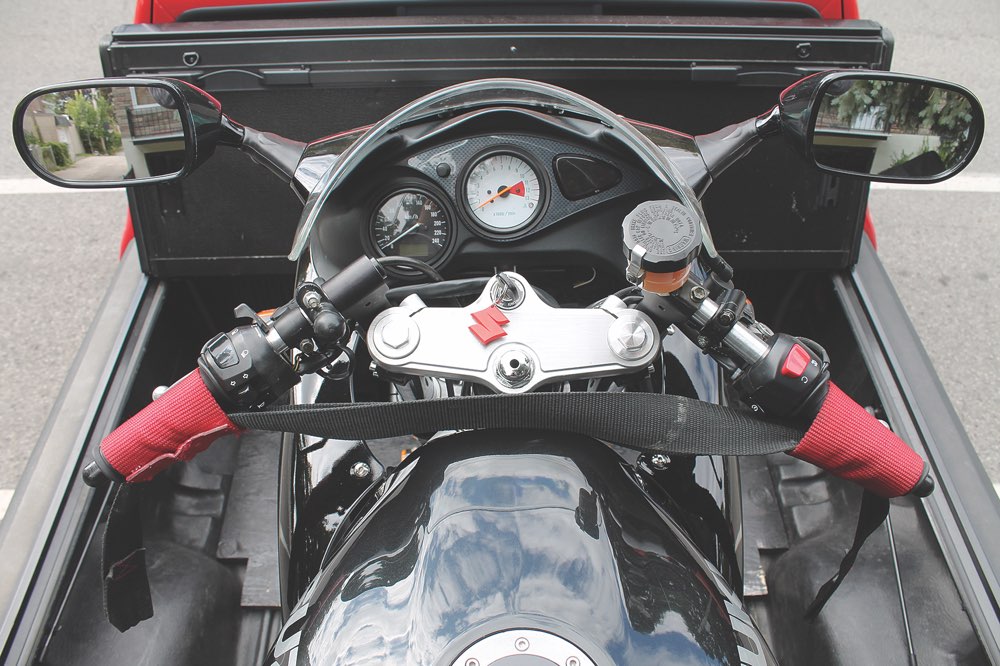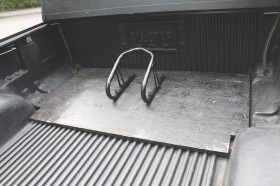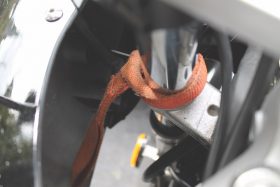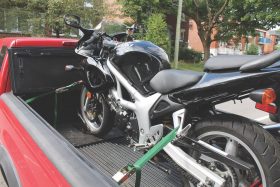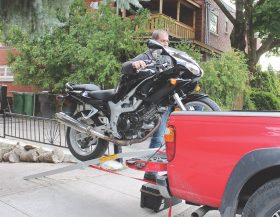A little preparation and know-how is all that’s needed to safely transport your bike.
Sometimes you need to transport your motorcycle, and probably the best way to do so is in a pickup truck. Using a pickup is more convenient than pulling a trailer, which also needs to be stored when not being used. An eight-foot bed of a full-size pickup is ideal, because you can load most bikes in it and close the tailgate. Because I live in the city, however, I own a 2008 Mazda B4000 compact pickup. It has a 6.5-foot bed, in which I can fit a full-size motorcycle with the tailgate down.
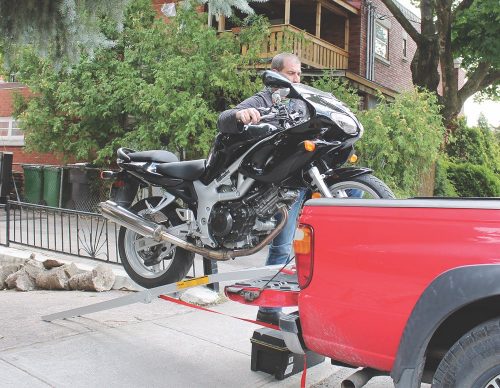 But you shouldn’t just drop your bike in the back of your pickup and drive off. It has to be secured properly, and there are a few things you should do to ensure safe transport. I have adapted my B4000 to carry almost any kind of motorcycle, safely, and it cost less than $300.
But you shouldn’t just drop your bike in the back of your pickup and drive off. It has to be secured properly, and there are a few things you should do to ensure safe transport. I have adapted my B4000 to carry almost any kind of motorcycle, safely, and it cost less than $300.
To strap a bike down securely, I highly recommend using a wheel chock. A wheel chock keeps the front end from turning while in transport, and it keeps the front wheel off the bed’s forward wall, which can bend with time and, in extreme cases, come into contact with the cab, which will rattle you crazy.
I don’t like drilling holes into my truck, so I bolted a wheel chock into a piece of ¾-inch plywood that I cut to fit snugly into the front part of the bed. Aside from avoiding poking holes into my truck, another advantage of doing it this way is that the chock and plywood can be easily removed if I need to load other items into the truck, like furniture. My 16.5 cm-wide BikeMaster wheel chock cost $45. Motorsport Products offers a mechanical one for $154 that holds the bike upright, making strapping it down easier.
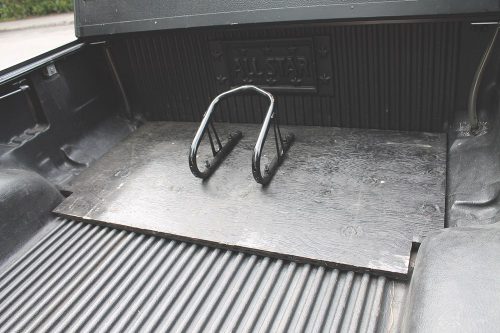 A plank of wood works as a ramp, but it’s cumbersome and impractical. A more expensive but much more practical alternative is a purpose-made metal ramp. I bought a folding aluminum ramp made by Moose Racing (retails for $167), rated at 600 lb. It’s lightweight and folds for convenient storage. When unfolded, it’s about 2.5 metres long, and it’s arched; an arched ramp is better than a flat ramp because it provides a smoother transition from ramp to pickup, so there’s less chance of hooking up the undercarriage of the bike as it rolls into the bed. Another trick to reduce this is to back your pickup into a curb, using the raised sidewalk to reduce the angle of the ramp.
A plank of wood works as a ramp, but it’s cumbersome and impractical. A more expensive but much more practical alternative is a purpose-made metal ramp. I bought a folding aluminum ramp made by Moose Racing (retails for $167), rated at 600 lb. It’s lightweight and folds for convenient storage. When unfolded, it’s about 2.5 metres long, and it’s arched; an arched ramp is better than a flat ramp because it provides a smoother transition from ramp to pickup, so there’s less chance of hooking up the undercarriage of the bike as it rolls into the bed. Another trick to reduce this is to back your pickup into a curb, using the raised sidewalk to reduce the angle of the ramp.
When using a ramp, you should always attach it to the bumper or hitch of your truck with a tie-down to prevent it from sliding away as you load your bike, which leads to disaster. I like to exert as little energy as possible when loading a bike, and unless it doesn’t run, I always load a bike under its own power. This takes a very steady clutch hand, and of course I do so by walking next to the bike and not riding it into the back of my pickup. An intermediate step of some kind makes the operation of walking onto the tailgate much smoother.
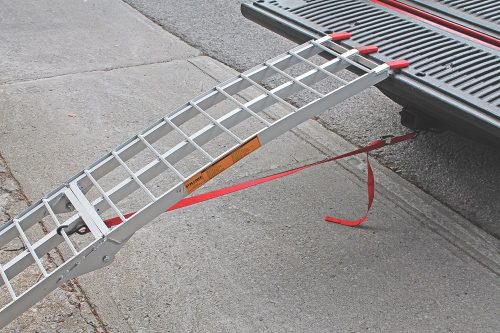
I prefer ratchet-type tie-downs over the friction type, which may cost less, but as they wear, they tend to slip. A ratcheting tie-down has a mechanical system that prevents the strap from loosening. Fortunately, my truck has sturdy tie-down hooks in the bed at the four corners. Most new trucks have sturdy hooks; older trucks don’t, so you might have to do some drilling to install some. The forward hooks should be located so that they pull the bike down and forward. To reduce the risk of damaging the bike, I use assist straps (like ones from Erickson for $6) between the bike and the tie-downs’ metal hooks. The best forward location to hook the tie-downs onto the bike is at the fork tubes, by the lower triple clamp. If not accessible, the handlebar is the next best location. You can use specialized handlebar straps (from Steadymate, $13) that fit over the handgrips and provide a loop to hook tie-downs into, but I don’t use them, since they tend to twist the grips.
When you’re tying down a bike, it should be straight up and down on its wheels, not on the side or centre stands, and you should compress the front suspension to about half its travel for the proper tension. Also tie down the rear end, so it doesn’t bounce around. Here, you’ll have to find a solid anchor location; if there’s none available, the swingarm or wheel will do. Once loaded and properly attached with the right gear, nothing short of a rollover will cause the bike to fall over.
Technical articles are written purely as reference only and your motorcycle may require different procedures. You should be mechanically inclined to carry out your own maintenance and we recommend you contact your mechanic prior to performing any type of work on your bike.









